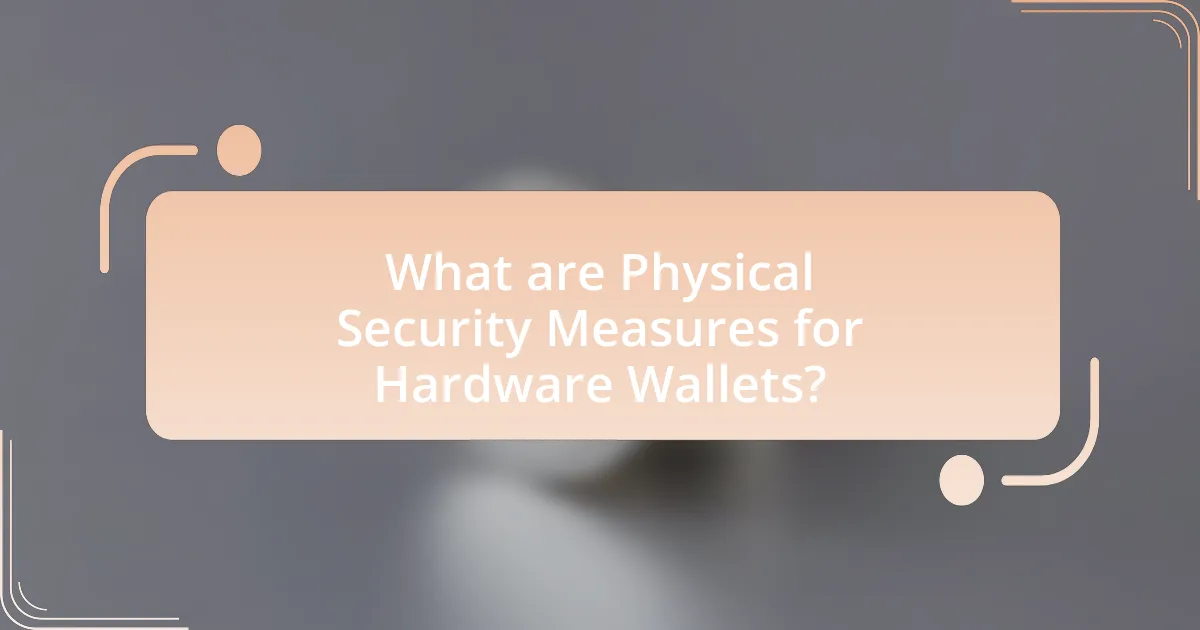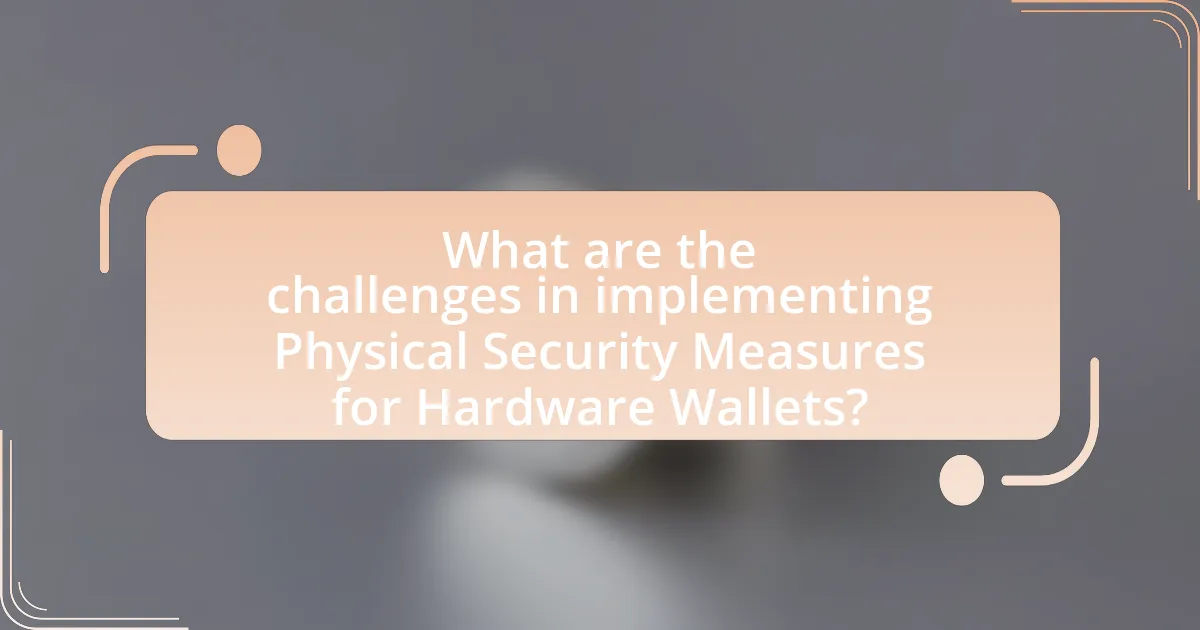Physical security measures for hardware wallets are essential for safeguarding sensitive cryptocurrency assets against theft and unauthorized access. Key measures include secure storage solutions, tamper-evident packaging, and access control methods such as biometric authentication and PIN protection. The article outlines the importance of these measures, the risks associated with inadequate physical security, and best practices for users to enhance the safety of their hardware wallets. Additionally, it discusses the challenges users face in implementing these measures and the role of technology in improving security protocols.

What are Physical Security Measures for Hardware Wallets?
Physical security measures for hardware wallets include secure storage, tamper-evident packaging, and access control. Secure storage involves keeping the hardware wallet in a safe or locked location to prevent unauthorized access. Tamper-evident packaging ensures that any unauthorized attempts to access the wallet are visibly detectable, thus maintaining the integrity of the device. Access control measures, such as biometric authentication or PIN protection, restrict access to the wallet, ensuring that only authorized users can interact with it. These measures collectively enhance the security of hardware wallets against physical theft and tampering.
Why are Physical Security Measures important for Hardware Wallets?
Physical security measures are crucial for hardware wallets because they protect sensitive private keys from theft and unauthorized access. Hardware wallets store cryptocurrencies offline, making them less vulnerable to online attacks; however, if a physical device is compromised, such as through theft or tampering, the security of the stored assets is at risk. For instance, a study by the European Union Agency for Cybersecurity highlights that physical attacks can lead to significant financial losses, emphasizing the need for robust physical security protocols. Implementing measures like tamper-evident seals, secure storage locations, and biometric access can significantly reduce the risk of unauthorized access and ensure the integrity of the hardware wallet.
What risks do Hardware Wallets face without Physical Security Measures?
Hardware wallets face significant risks without physical security measures, primarily including theft, unauthorized access, and tampering. Without adequate physical protection, these devices can be easily stolen or accessed by malicious actors, leading to the loss of cryptocurrency assets. For instance, a study by the European Union Agency for Cybersecurity highlights that physical attacks on hardware wallets can result in complete compromise of the stored private keys, allowing attackers to transfer funds without the owner’s consent. Additionally, the lack of tamper-evident features can enable attackers to manipulate the device without detection, further increasing the risk of asset loss.
How do Physical Security Measures enhance the safety of Hardware Wallets?
Physical security measures enhance the safety of hardware wallets by providing protection against unauthorized access and physical tampering. These measures include secure storage solutions, such as safes or locked cabinets, which prevent theft and unauthorized handling. Additionally, features like tamper-evident seals and biometric authentication ensure that any attempt to access the wallet is immediately detectable, thereby safeguarding the private keys stored within. For instance, a study by the National Institute of Standards and Technology highlights that physical security controls significantly reduce the risk of data breaches, emphasizing the importance of protecting hardware wallets from physical threats.
What types of Physical Security Measures are commonly used for Hardware Wallets?
Common physical security measures for hardware wallets include tamper-evident seals, secure storage solutions, and biometric authentication. Tamper-evident seals alert users to unauthorized access attempts, while secure storage solutions, such as safes or locked drawers, protect the wallet from theft. Biometric authentication, like fingerprint scanning, adds an additional layer of security by ensuring that only authorized users can access the wallet. These measures are essential for safeguarding digital assets against physical threats.
What are the most effective physical barriers for protecting Hardware Wallets?
The most effective physical barriers for protecting hardware wallets include secure storage solutions, tamper-evident packaging, and environmental controls. Secure storage solutions, such as safes or locked drawers, prevent unauthorized access and physical theft. Tamper-evident packaging ensures that any unauthorized attempts to access the wallet are visibly detectable, thus deterring tampering. Environmental controls, including humidity and temperature regulation, protect the hardware from damage that could compromise its functionality. These measures collectively enhance the security of hardware wallets by minimizing risks associated with physical theft and environmental factors.
How do environmental controls contribute to the security of Hardware Wallets?
Environmental controls enhance the security of hardware wallets by regulating conditions such as temperature, humidity, and physical access, which can prevent damage and unauthorized access. For instance, maintaining optimal temperature and humidity levels protects the electronic components from degradation, while secure physical access measures, such as locked enclosures or restricted areas, deter tampering or theft. Studies have shown that environments with controlled access and monitored conditions significantly reduce the risk of hardware compromise, thereby ensuring the integrity and security of the stored digital assets.
How can users implement Physical Security Measures for their Hardware Wallets?
Users can implement physical security measures for their hardware wallets by storing them in a secure location, such as a safe or a locked drawer, to prevent unauthorized access. Additionally, users should utilize tamper-evident seals to detect any unauthorized attempts to access the wallet. Employing a strong password or PIN for the wallet adds another layer of security, as it protects against unauthorized use even if the device is physically accessed. Furthermore, users should avoid connecting their hardware wallets to public or unsecured computers, as this can expose them to malware or hacking attempts. These measures are essential because hardware wallets are often targeted by thieves and hackers, making physical security critical for safeguarding digital assets.
What best practices should users follow to secure their Hardware Wallets physically?
To secure hardware wallets physically, users should store them in a safe, dry, and secure location, such as a locked safe or a safety deposit box. This practice minimizes the risk of theft, loss, or damage. Additionally, users should avoid leaving their hardware wallets in easily accessible places, such as desks or bags, where they can be stolen or misplaced. Implementing a routine to regularly check the physical condition of the wallet ensures that it remains functional and secure. Furthermore, users should consider using tamper-evident seals or cases to detect unauthorized access. These measures collectively enhance the physical security of hardware wallets, protecting users’ digital assets from potential threats.
How can users assess the effectiveness of their Physical Security Measures?
Users can assess the effectiveness of their physical security measures by conducting regular security audits and vulnerability assessments. These evaluations involve systematically reviewing the physical barriers, access controls, and surveillance systems in place to identify potential weaknesses. For instance, a study by the National Institute of Standards and Technology (NIST) emphasizes the importance of testing security measures against real-world scenarios to ensure they can withstand unauthorized access attempts. Additionally, tracking incidents of theft or tampering can provide concrete data on the effectiveness of existing measures, allowing users to make informed adjustments based on empirical evidence.

What are the challenges in implementing Physical Security Measures for Hardware Wallets?
Implementing physical security measures for hardware wallets faces several challenges, including the risk of physical theft, the need for user education, and the balance between security and usability. Physical theft remains a significant concern, as hardware wallets can be stolen or tampered with, leading to potential loss of funds. User education is crucial, as many users may not understand the importance of securing their wallets or how to properly implement security measures, such as using secure storage locations or employing additional protective devices. Furthermore, achieving a balance between robust security features and user-friendly design is challenging; overly complex security measures can deter users from effectively utilizing the wallet. These challenges highlight the need for ongoing improvements in both technology and user awareness to enhance the physical security of hardware wallets.
What common obstacles do users face when securing Hardware Wallets?
Users face several common obstacles when securing hardware wallets, including the risk of physical theft, loss of the device, and inadequate knowledge of security practices. Physical theft poses a significant threat, as hardware wallets can be stolen if not properly secured, leading to potential loss of funds. Additionally, users may misplace their wallets, resulting in permanent loss of access to their cryptocurrencies. Furthermore, many users lack sufficient understanding of best security practices, such as the importance of using strong PINs, keeping recovery phrases secure, and regularly updating firmware, which can leave them vulnerable to attacks. These challenges highlight the need for better education and awareness regarding hardware wallet security.
How can users overcome these challenges effectively?
Users can effectively overcome challenges related to physical security measures for hardware wallets by implementing multi-layered security protocols. These protocols include using tamper-evident seals, storing wallets in secure locations, and employing biometric authentication methods. For instance, tamper-evident seals provide a visible indication of unauthorized access, while secure storage locations, such as safes or safety deposit boxes, reduce the risk of theft. Additionally, biometric authentication adds an extra layer of security by ensuring that only authorized users can access the wallet. According to a study by the National Institute of Standards and Technology, implementing multiple security measures significantly decreases the likelihood of unauthorized access, thereby enhancing the overall security of hardware wallets.
What role does user awareness play in the effectiveness of Physical Security Measures?
User awareness is crucial for the effectiveness of physical security measures, as it directly influences how individuals interact with security protocols and devices. When users are informed about potential threats and the importance of adhering to security practices, they are more likely to engage in behaviors that enhance security, such as properly securing hardware wallets and recognizing suspicious activities. Studies indicate that human error is a significant factor in security breaches; for instance, a report by the Ponemon Institute found that 95% of cybersecurity incidents are attributed to human mistakes. Therefore, enhancing user awareness through training and education can significantly reduce vulnerabilities and improve the overall security posture of physical security measures.
How do advancements in technology impact Physical Security Measures for Hardware Wallets?
Advancements in technology significantly enhance physical security measures for hardware wallets by integrating sophisticated encryption, biometric authentication, and tamper-resistant designs. These innovations ensure that unauthorized access is minimized; for instance, biometric features like fingerprint or facial recognition provide an additional layer of security that traditional PINs do not offer. Furthermore, advancements in materials and manufacturing processes have led to the development of tamper-evident seals and secure elements that can detect physical intrusion attempts. According to a report by the International Journal of Information Security, hardware wallets utilizing these advanced technologies have shown a 50% reduction in successful unauthorized access attempts compared to older models.
What new technologies are emerging to enhance the physical security of Hardware Wallets?
Emerging technologies enhancing the physical security of hardware wallets include biometric authentication, secure enclaves, and tamper-evident packaging. Biometric authentication, such as fingerprint or facial recognition, adds a layer of security by ensuring that only authorized users can access the wallet. Secure enclaves, which are isolated processing environments within the hardware, protect sensitive data from unauthorized access and attacks. Tamper-evident packaging serves as a physical deterrent, alerting users to any unauthorized access attempts. These advancements are crucial as they address vulnerabilities in existing hardware wallet designs, thereby improving overall security.
How can users stay updated on the latest security technologies for Hardware Wallets?
Users can stay updated on the latest security technologies for hardware wallets by following reputable cryptocurrency news websites, subscribing to industry newsletters, and participating in online forums dedicated to cryptocurrency security. Reputable sources such as CoinDesk and CryptoSlate regularly publish articles on advancements in hardware wallet security. Additionally, newsletters from hardware wallet manufacturers like Ledger and Trezor provide updates on new features and security protocols. Engaging in forums such as Reddit’s r/CryptoCurrency allows users to discuss and share information about the latest security technologies and practices.

What are the best practices for maintaining Physical Security Measures for Hardware Wallets?
The best practices for maintaining physical security measures for hardware wallets include storing the wallet in a secure location, using tamper-evident seals, and regularly updating security protocols. Secure storage can involve keeping the wallet in a safe or a locked drawer to prevent unauthorized access. Tamper-evident seals provide a visual indication if the device has been compromised, ensuring that users can detect any unauthorized attempts to access the wallet. Regularly updating security protocols, such as changing passwords and enabling two-factor authentication, enhances protection against potential threats. These practices are essential for safeguarding digital assets, as hardware wallets are often targeted by thieves due to their value.
How can users regularly evaluate their Physical Security Measures?
Users can regularly evaluate their physical security measures by conducting routine assessments that include checking the integrity of physical barriers, reviewing access controls, and testing alarm systems. Regular assessments should involve a checklist that verifies the functionality of locks, surveillance equipment, and environmental controls, ensuring that all components are operational and effective. Additionally, users should perform periodic audits of who has access to secure areas and update access permissions as necessary. According to the National Institute of Standards and Technology (NIST), regular evaluations help identify vulnerabilities and improve overall security posture, thereby reducing the risk of unauthorized access or theft.
What tools or methods can assist in assessing the security of Hardware Wallets?
To assess the security of hardware wallets, tools such as penetration testing frameworks, firmware analysis tools, and physical security assessment methods are essential. Penetration testing frameworks like Metasploit can identify vulnerabilities in the wallet’s software, while firmware analysis tools such as Binwalk allow for the examination of the wallet’s firmware for security flaws. Additionally, physical security assessments, including side-channel analysis and tamper-evidence testing, help evaluate the hardware’s resilience against physical attacks. These methods collectively provide a comprehensive evaluation of the security posture of hardware wallets.
How often should users review and update their Physical Security Measures?
Users should review and update their Physical Security Measures at least annually. Regular reviews help identify vulnerabilities and adapt to evolving security threats. According to the National Institute of Standards and Technology (NIST), organizations should conduct security assessments annually to ensure that physical security measures remain effective and relevant to current risks. This proactive approach minimizes the risk of unauthorized access and enhances overall security posture.
What practical tips can users follow to enhance the physical security of their Hardware Wallets?
To enhance the physical security of hardware wallets, users should implement several practical measures. First, store the hardware wallet in a secure location, such as a safe or a locked drawer, to prevent unauthorized access. Second, utilize tamper-evident seals to detect any unauthorized attempts to access the wallet. Third, regularly update the wallet’s firmware to protect against vulnerabilities, as manufacturers often release updates to address security flaws. Fourth, avoid connecting the hardware wallet to untrusted devices or networks, which can expose it to malware. Lastly, consider using a strong passphrase in addition to the wallet’s PIN for an extra layer of security. These measures are supported by security best practices that emphasize the importance of physical protection and software integrity in safeguarding digital assets.
What simple actions can users take to improve their Hardware Wallet security today?
Users can improve their hardware wallet security today by implementing several straightforward actions. First, they should always keep their hardware wallet in a secure location, such as a safe or a locked drawer, to prevent unauthorized access. Additionally, users must ensure that they regularly update the wallet’s firmware to protect against vulnerabilities; for instance, manufacturers often release updates that address security flaws. Furthermore, users should create strong, unique PINs or passwords for their wallets, as weak credentials can be easily compromised. Lastly, users should avoid connecting their hardware wallets to public or unsecured computers, as this can expose them to malware or hacking attempts. These actions collectively enhance the security of hardware wallets and protect users’ digital assets.
How can users educate themselves and others about Hardware Wallet security?
Users can educate themselves and others about Hardware Wallet security by accessing reputable online resources, participating in community forums, and attending workshops focused on cryptocurrency security. Reputable sources include official hardware wallet websites, cybersecurity blogs, and educational platforms that provide detailed guides on best practices for securing hardware wallets. Community forums, such as Reddit or specialized cryptocurrency groups, allow users to share experiences and learn from others’ insights. Workshops and webinars hosted by experts in the field offer hands-on training and up-to-date information on security measures. Engaging with these resources enhances understanding and promotes awareness of potential threats and protective strategies.